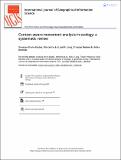Files in this item
Context-aware movement analysis in ecology : a systematic review
Item metadata
| dc.contributor.author | Brum-Bastos, Vanessa | |
| dc.contributor.author | Łoś, Marcelina | |
| dc.contributor.author | Long, Jed | |
| dc.contributor.author | Nelson, Trisalyn | |
| dc.contributor.author | Demsar, Urska | |
| dc.date.accessioned | 2021-08-11T16:30:15Z | |
| dc.date.available | 2021-08-11T16:30:15Z | |
| dc.date.issued | 2022 | |
| dc.identifier | 275239586 | |
| dc.identifier | a4d6132e-5dc7-4e60-9b41-36996c975d07 | |
| dc.identifier | 000683215700001 | |
| dc.identifier | 85112045824 | |
| dc.identifier.citation | Brum-Bastos , V , Łoś , M , Long , J , Nelson , T & Demsar , U 2022 , ' Context-aware movement analysis in ecology : a systematic review ' , International Journal of Geographical Information Science , vol. 36 , no. 2 , pp. 405-427 . https://doi.org/10.1080/13658816.2021.1962528 | en |
| dc.identifier.issn | 1365-8816 | |
| dc.identifier.uri | https://hdl.handle.net/10023/23763 | |
| dc.description | This work was supported by the Coordination for the Improvement of Higher Education Personnel (BEX:13438/13-1), the Leverhulme Trust Research Project Grant (RPG-2018-258); the Discovery grant from the Natural Sciences and Engineering Research Council of Canada the Polish National Science Centre (UMO-2019/35/O/ST6/04127). | en |
| dc.description.abstract | Research on movement has increased over the past two decades, particularly in movement ecology, which studies animal movement. Taking context into consideration when analysing movement can contribute towards the understanding and prediction of behaviour. The only way for studying animal movement decision-making and their responses to environmental conditions is through analysis of ancillary data that represent conditions where the animal moves. In GIScience this is called Context-Aware Movement Analysis (CAMA). As ecology becomes more data-oriented, we believe that there is a need to both review what CAMA means for ecology in methodological terms and to provide reliable definitions that will bridge the divide between the content-centric and data-centric analytical frameworks. We reviewed the literature and proposed a definition for context, develop a taxonomy for contextual variables in movement ecology and discuss research gaps and open challenges in the science of movement more broadly. We found that the main research for CAMA in the coming years should focus on: 1) integration of contextual data and movement data in space and time, 2) tools that account for the temporal dynamics of contextual data, 3) ways to represent contextualized movement data, and 4) approaches to extract meaningful information from contextualized data. | |
| dc.format.extent | 23 | |
| dc.format.extent | 2574189 | |
| dc.language.iso | eng | |
| dc.relation.ispartof | International Journal of Geographical Information Science | en |
| dc.subject | Movement analysis | en |
| dc.subject | Tracking data | en |
| dc.subject | Environmental data | en |
| dc.subject | Context | en |
| dc.subject | Movement ecology | en |
| dc.subject | G Geography (General) | en |
| dc.subject | Z665 Library Science. Information Science | en |
| dc.subject.lcc | G1 | en |
| dc.subject.lcc | Z665 | en |
| dc.title | Context-aware movement analysis in ecology : a systematic review | en |
| dc.type | Journal item | en |
| dc.contributor.sponsor | The Leverhulme Trust | en |
| dc.contributor.institution | University of St Andrews. School of Geography & Sustainable Development | en |
| dc.contributor.institution | University of St Andrews. Bell-Edwards Geographic Data Institute | en |
| dc.contributor.institution | University of St Andrews. Environmental Change Research Group | en |
| dc.identifier.doi | 10.1080/13658816.2021.1962528 | |
| dc.description.status | Peer reviewed | en |
| dc.identifier.grantnumber | RPG-2018-258 | en |
This item appears in the following Collection(s)
Items in the St Andrews Research Repository are protected by copyright, with all rights reserved, unless otherwise indicated.

